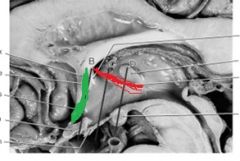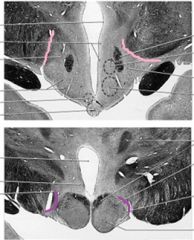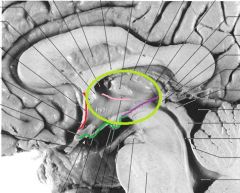![]()
![]()
![]()
Use LEFT and RIGHT arrow keys to navigate between flashcards;
Use UP and DOWN arrow keys to flip the card;
H to show hint;
A reads text to speech;
64 Cards in this Set
- Front
- Back
|
what is the rostral boundary of the hypothalamus?
|
lamina terminalis
|
|
|
what is the dorsal boundary of the hypothalamus?
|
hypothalamic sulcus
|
|
|
what is the medial boundary of the hypothalamus?
|
3rd ventricle
|
|

Name the Red line and the Green line
|
Red line = hypothalamic sulcus
Green line= Lamina terminalis |
|
|
what does the lumen of the neural tube become in regards to the hypothalamus?
|
the 3rd ventricle
|
|
|
what does the notch at the boundary between the lumen of the neural tube and the wall become?
|
hypothalamic sulcus
|
|
|
what is the lateral boundary of the hypothalamus? (rostrally and caudally)
|
substantia innominata-rostrally and the posterior limbs of the internal capsules caudally.
|
|

Name the pink line and the purple line.
|
pink= substantia innominata
purple= posterior limbs of the internal capsules |
|
|
what are the ventral boundaries of the hypothalamus? (3)
|
infundibular stalk, brain surface, and the line btwn mammillary bodies and posterior commissure.
|
|

Name all of the colored lines and circle.
|
Green circle: 3rd ventricle
dark green line: infundibular stalk and brain surface red line: lamina terminalis purple line: line between mammillary bodies and posterior commissure pink line: hypothalamic sulcus |
|
|
what are the 3 ventral landmarks?
|
infundibulum, tuber cinerium and mammillary bodies.
|
|
|
what 3 zones/ nuclei are located rostral of optic chiasm in the preoptic level?
|
periventricular zone, medial preoptic nucleus and lateral preoptic nucleus.
|
|
|
what is the function of the periventricular zone?
|
neuroendocrine
|
|
|
what is the function of the medial preoptic neurons? what hormone pituitary hormone is controlled by these neurons? what factor do they release?
|
temperature detection; it regulates set point. LH and FSH and their factor is GnRH.
|
|
|
what six nuclei/ zones/ structures are located over the optic chiasm in the supraoptic level?
|
periventricular zone, anterior nucleus, supraoptic, paraventricular, suprachiasmatic nucleus and lateral hypothalamus.
|
|
|
what two hormones are controlled by the supraoptic nucleus?
|
oxytocin and ADH
|
|
|
what hormone does the periventricular zone control? what factor is associated with this hormone?
|
TSH; somatostatin
|
|
|
what hormones does the paraventricular zone control? what factor is associated with these hormones?
|
ACTH, TSH, prolactin---> CRH, TRH, and PRF (respectively)
|
|
|
what is the function of the suprachiasmatic? what will happen to this if affected by a lesion?
|
fxn: controls circadian rhythms... lesion- disruption in diurnal cycles.
|
|
|
what is the function of the lateral hypothalamus? what will happen is a lesion affects the lateral hypothalamus?
|
fxn: feeding and wakefulness
lesion: anorexia and narcolepsy |
|
|
at the tuberal level, what is found posterior to optic chiasm?
|
periventricular zone, arcuate nucleus, ventromedial nucleus, dorsomedial nucleus, and lateral hypothalamus.
|
|
|
what is the function of the arcuate nucleus? what are the 2 populations of cells that is contains?
|
fxn: feeding
cells: 1) orexigenic (stimulate feeding) and 2) arexigenic (inhibit feeding) |
|
|
what is excitatory to anorexigenic cell?
|
Leptin
|
|
|
what is excitatory to an orexigenic cell?
|
Ghrelin
|
|
|
what is the function of the ventromedial nucleus? what would happen if a lesion affected this area?
|
fxn: feeding (satiety center)
lesion: hyperphagia, obesity |
|
|
what is the function of dorsomedial nucleus? what would a lesion of this area cause?
|
hyperphagia, obesity
|
|
|
what is located at the mammillary level which is over the mammillary bodies?
|
periventricular zone, mammillary body, posterior nucleus, lateral hypothalamus- tuberomammillary nucleus
|
|
|
what is the function of the posterior nucleus? what would happen if a lesion affected this area?
|
fxn:increased sympathetic output and increased in thermogenesis
lesion: horner's syndrome and poikilothermia (respectively) |
|
|
what is the function of the mammillary body? what would happen if a lesion affected this area?
|
fxn: memory consolidation
lesion: anterograde amnesia |
|
|
what is the function of the tuberomammillary? what would happen if a lesion affected this area?
|
fxn: wakefulness
lesion: hypersomnia |
|
|
what is the blood supply for the hypothalamus? (anterior, tuberal, and posterior
|
anterior: anterior cerebral and anterior communicating arteries
tuberal: posterior communicating artery posterior: posterior communicating and posterior cerebral artery and basilar artery. |
|
|
which hypophysial division is neural in origin and is a circumventricular organ?
|
posterior pituitary
|
|
|
what is the pituitary portal system blood flow order?
|
superior and inferior hypophysial artery --> primary capillary plexus --> hypophsial portal veins --> secondary capillary plexus --> veins to cavernous sinus
|
|
|
what is the largest input to hypothalamus?
|
fornix
|
|
|
what is the source of the fornix?
|
subiculum and hippocampus
|
|
|
where does the hippocampus input go to? what is its function?
|
input is to preoptic and supraoptic area.
fxn: Memory associated modulation of sympathetic activity. |
|
|
where does the subiculum input go to? what is its function?
|
input: mammillary bodies
fxn: memory consolidation circuitry |
|
|
what are the two pathways of the amigdalohypothalamic pathway?
|
1) stria terminalis and 2) ventral amygdalofugal pathway
|
|
|
what is the function of the amigdalohypothalamic pathway?
|
binds autonomic aspects of emotional components to experiences.
|
|
|
what is the major pathway for ascending and descending fibers? what is the function?
|
medial forebrain bundle; fxn: diverse information conveyed.
|
|
|
T/F
the medial forebrain bundle contains both afferents and efferents. |
true
|
|
|
what is the hypothalamic afferent tract?
|
amigdalohypothalamic pathway
|
|
|
what is the function of the mammillothalamic tract?
|
memory consolidation
|
|
|
what is the direct course of the hypothalamospinal tract?
|
fibers from hypothalamic nuclei connect with preganglionic cells --> medial forebrain bundle (lat zone of hypothalamus) --> periaqueductal gray matter --> dorsal tegmentum --> AL medulla --> lateral funiculus of spinal cord
|
|
|
where does the hypothalamospinal tract synapse for parasympathetic nuceli? sympathetic?
|
para- intermediate zone of sacral spinal cord
symp- IMCC of thoracolumbar spinal cord |
|
|
what is the direct course of the hypothalamomedullary tract?
|
fibers from hypothalamic nuclei--> preganglionic cells in brainstem --> medial forebrain bundle --> lateral zone of hypothalamus --> periaqueductal gray matter --> reticular formation
|
|
|
does the hypothalamomedullary tract synapse on parasympathetics or sympathetics? where are they located?
|
parasympathetics in the brainstem.
|
|
|
what is the function of the dorsal longitudinal fasciculus and mamilotegmental tract?
|
regulate pain sensitivity under stress.
|
|
|
what is the function of the anterior nucleus? if there was a lesion in this vicinity, what would it cause?
|
fxn: increased parasympathetic and decreased thermogenesis
lesion: deficits in parasympathetic fxn and hyperthermia |
|
|
which hormone, secreted by adipocytes is a long term signal of fat level? short term?
|
long- leptin
short- ghrelin |
|
|
if temperature is below set point, tell me what happens?
|
the medial preoptic activates posterior hypothalamic nucleus that activates sympathetic preganlionic cells to induce shivering and vasoconstriction
|
|
|
if temperature is above set point, what happens then?
|
medial preoptic activates anterior nucleus that activates parasympathetic preganglionic cells to induce sweating and vasodilation.
|
|
|
what usually occurs upon stimulation in the caudolateral portion of the thalamus? what would a lesion produce?
|
sympathetic tone= energy expansion (eg aggressive behavior, hunger, increased body temp)
lesion- increased parasympathetic tone |
|
|
what usually occurs upon stimulation of the rostromedial portion of the hypothalamus? what affect does a lesion have?
|
favors a parasympathetic tone= energy conservation (eg passive behavior, satiety, decreased body temp
lesion- increased sympathetic tone. |
|
|
what two tracts regulate the endocrine fxns?
|
supraoptichypophysial tract and tuberoinfundibular
|
|
|
what are the projections from in the supraopticohypophysial tract? what is released?
|
paraventricular and supraoptic; oxytocin and ADH are released.
|
|
|
T/F
The Peptides released due to the supraopticohypophysial tract are stored in herring bodies. |
FALSE:
since the posterior lobe has no BBB, then they are released direction into circulation. NO storage. |
|
|
what are the two potential causes of diabetes insipidus? how do they differ?
|
nephrogenic (insensitivity to ADH) and neurogenic (deficiency in ADH production)
|
|
|
To distinguish between the two form of diabetes insipidus, patients are challenged with an injection of desmopressin, an ADH analog. If the cause is neurogenic, you would expect plasma osmolarity to _______ following the injection. In contrast, if its nephrogenic plasma osmolarity will ___________.
|
decrease; stay the same
|
|
|
what four nuclei/zones project to the median eminence and infundibulum in the tuberinfudibular tract?
|
arcuate nucleus, periventricular zone, supraventricular and medial preoptic
|
|
|
where are the hormones released into via the tuberoinfudibular tract? where are they transported to?
|
enter primary plexus of portal system; secondary plexus where they induce troph cells to release hormone (or inhibition of release)
|
|
|
what accounts for 5% of intracranial adenomas?
|
pituitary adenomas
|
|
|
what are the two symptoms associated with both silent and nonsilent symptoms?
|
headache and bitemporal hemianopia
|
|
|
what are the top 3 excess hormones released by a nonsilent pituitary adenoma?
|
prolactin, GH, and ACTH.
|

